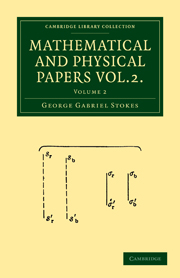Book contents
- Frontmatter
- Contents
- Notes on Hydrodynamics. III. On the Dynamical Equations
- On the constitution of the Luminiferous Ether
- On the Theory of certain Bands seen in the Spectrum
- Notes on Hydrodynamics. IV. Demonstration of a Fundamental Theorem
- On a difficulty in the Theory of Sound
- On the Formation of the Central Spot of Newton's Rings beyond the Critical Angle
- On some points in the Received Theory of Sound
- On the perfect Blackness of the Central Spot in Newton's Rings, and on the Verification of Fresnel's Formula for the intensities of Reflected and Reflacted Rays
- On Attractions, and on Clairaut's Theorem
- On the Variation of Gravity at the Surface of the Earth
- On a Mode of Measuring the Astigmatism of a Defective Eye
- On the Determination of the Wave Length corresponding with any Point of the Spectrum
- Discussion of a Differential Equation relating to the Breaking of Railway Bridges
- Notes on Hydrodynamics, VI. On Waves
- On the Dynamical Theory of Diffraction
- On the Numerical Calculation of a class of Definite Integrals and Infinite Series
- On the Mode of Disappearance of Newton's Rings in passing the Angle of Total Internal Reflection
- On Metallic Reflection
- On a Fictitious Displacement of Fringes of Interference
- On Haidinger's Brushes
- Index
On some points in the Received Theory of Sound
Published online by Cambridge University Press: 07 September 2010
- Frontmatter
- Contents
- Notes on Hydrodynamics. III. On the Dynamical Equations
- On the constitution of the Luminiferous Ether
- On the Theory of certain Bands seen in the Spectrum
- Notes on Hydrodynamics. IV. Demonstration of a Fundamental Theorem
- On a difficulty in the Theory of Sound
- On the Formation of the Central Spot of Newton's Rings beyond the Critical Angle
- On some points in the Received Theory of Sound
- On the perfect Blackness of the Central Spot in Newton's Rings, and on the Verification of Fresnel's Formula for the intensities of Reflected and Reflacted Rays
- On Attractions, and on Clairaut's Theorem
- On the Variation of Gravity at the Surface of the Earth
- On a Mode of Measuring the Astigmatism of a Defective Eye
- On the Determination of the Wave Length corresponding with any Point of the Spectrum
- Discussion of a Differential Equation relating to the Breaking of Railway Bridges
- Notes on Hydrodynamics, VI. On Waves
- On the Dynamical Theory of Diffraction
- On the Numerical Calculation of a class of Definite Integrals and Infinite Series
- On the Mode of Disappearance of Newton's Rings in passing the Angle of Total Internal Reflection
- On Metallic Reflection
- On a Fictitious Displacement of Fringes of Interference
- On Haidinger's Brushes
- Index
Summary
I proceed now to notice the apparent contradiction at which Professor Challis has arrived by considering spherical waves, a contradiction which it is the chief object of this communication to consider. The only reason why I took no notice of it in a former communication was, that it was expressed with such brevity by Professor Challis (Vol. XXXII. p. 497), that I did not perceive how the conclusion that the condensation varies inversely as the square of the distance was arrived at. On mentioning this circumstance to Professor Challis, he kindly explained to me his reasoning, which he has since stated in detail (Vol. XXXIII. p. 463).
The whole force of the reasoning rests on the tacit supposition that when a wave is propagated from the centre outwards, any arbitrary portion of the wave, bounded by spherical surfaces concentric with the bounding surfaces of the wave, may be isolated, the rest of the wave being replaced by quiescent fluid; and that being so isolated, it will continue to be propagated outwards as before, all the fluid except the successive portions which form the wave in its successive positions being at rest. At first sight it might seem as if this assumption were merely an application of the principle of the coexistence of small motions, but it is in reality extremely different. The equations are competent to decide whether the isolation be possible or not.
- Type
- Chapter
- Information
- Mathematical and Physical Papers , pp. 82 - 88Publisher: Cambridge University PressPrint publication year: 2009First published in: 1883



